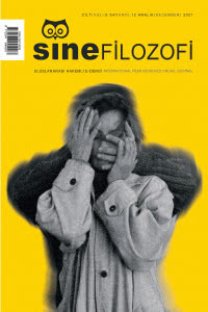Desire And Decadence In The Film Bildnis Einer Trinkerin (1979) As An Aesthetic Modernist Reaction
Estetik Modernizm, Ulrike Ottinger, Bildnis Einer Trinker, Arzu, Dekadans
Desire And Decadence In The Film Bildnis Einer Trinkerin (1979) As An Aesthetic Modernist Reaction
Aesthetic Modernism, Ulrike Ottinger, Bildnis Einer Trinkerin, Desire, Decadence,
___
- Artun, A. (2004). Baudelaire’de Sanatın Özerkleşmesi ve Modernizm. Retrieved from http://www.aliartun.com/yazilar/baudelairede-sanatin-ozerklesmesi-ve-modernizm/
- Blumenschein, T. & Ottinger, U. (Producer), Ottinger, U. & Blumenschein, T. (Director). (1975). Die Betörung Der Blauen Matrosen [Motion Picture]. Germany: Helmut Wietz.
- Blumenschein, T. & Ottinger, U. (Producer), Ottinger, U. & Blumenschein, T. (Director). (1975). Laokoon & Söhne [Motion Picture]. Germany.
- Blumenschein, T. & Ottinger, U. (Producer), Ottinger, U. & Blumenschein, T. (Director). (1978). Madame X - Eine Absolute Herrscherin [Motion Picture]. Germany: Zweites Deutsches Fernsehen.
- Carrington, L. (2020). İlksel Kargaşaya Dönmek: Sihirli Sanat Hakkında. Uraz Aydın (Translated by). Retrieved from https://www.e-skop.com/skopbulten/ilksel-kargasaya-donmek-sihirli-sanat-hakkinda/6040
- Çeli̇k, T. (2020). Sırta Bakış / Sırtın Bakışı: Sinemada Estetik Modernizm Bağlamında Sırt Takip Plan. SineFilozofi, 5 (9), 435-462. DOI: 10.31122/sinefilozofi.737140
- Deleuze, G., Guattari, F. (2000). Anti-Oedipus Capitalism and Schizophrenia (10th Edition). Robert Hurley, Mark Seem, and Helen R. Lane (Translated by). Minneapolis: University of Minnesota
- Glickstein, A. (2020). Ulrike Ottinger’s Strange Subversions. Retrieved from https://mubi.com/de/notebook/posts/ulrike-ottinger-s-strange-subversions
- Handel, D. (2020). Sürüp Gider Bir Orman Gibi. Eda Sezgin (Translated by). Retrieved from https://e-skop.com/skopbulten/surup-gider-bir-orman-gibi/5910
- Holland, E. W. (2007). Deleuze ve Guattari’nin Anti-Oedipus’u. Ali Utku, Mukadder Erken (Translated by). İstanbul: Otonom.
- Makary, J. (2020). ‘Still Moving’: Ulrike Ottinger’s Shifting Archive of Identity. Retrieved from https://www.anothergaze.com/still-moving-ulrike-ottingers-shifting-archive-identity/
- Mengershausen, J. V. & Ottinger, U. (Producer), Ottinger, U. (Director). (1984). Dorian Gray Im Spiegel Der Boulevardpresse [Motion Picture]. Germany: Sender Freies Berlin.
- Mollaer, F. (2015). Baudelaire’in Modernlik Kehanetleri: Modernleşmeye Karşı Estetik Modernizm. Retrieved from https://www.e-skop.com/skopbulten/baudelairein-modernlik-kehanetleri-modernlesmeye-karsi-estetik-modernizm/2310
- Ottinger, U. (Producer), Ottinger, U. (Director). (1973). Berlinfieber - Wolf Vostell [Short Film]. Germany: The Wolf Vostell Estate.
- Ottinger, U. (2010). Biography. Retrieved from https://www.ulrikeottinger.com/en/biography
- Ottinger, U. (1979). Ticket of No Return. Retrieved from https://www.ulrikeottinger.com/en/film-details/ticket-of-no-return
- Öğüt, H. (2019). Kalem, Penisin Metaforu Mudur?. Psikeart, 65, 106-111.
- Paglia, C. (2004). Cinsel Kimlikler. Anahid Hazaryan, Fikriye Demirci (Translated by). Ankara: Epos.
- Sherlock, A. (2019). Following Ulrike Ottinger to the End of the World. Retrieved from https://www.frieze.com/article/following-ulrike-ottinger-end-world
- Smelik, A. (2008). Feminist Sinema ve Film Teorisi ve Ayna Çatladı. Deniz Koç (Translated by). İstanbul: Agora.
- Sontag, S. (2009). Notes on “Camp”. Retrieved from https://classes.dma.ucla.edu/Spring15/104/Susan%20Sontag_%20Notes%20On%20-Camp-.pdf Stein, U., Stein, E., Ottinger, U. & Blumenschein (Producer), Ottinger, U. (Director). (1979). Bildnis Einer Trinkerin [Motion Picture]. Germany: Zweites Deutsches Fernsehen.
- Uttenburger, A. L. (1999). The St. James Women Filmmakers Encyclopedia: Women on the Other Side of the Camera. Canton: Visible Ink.
- Waters, A. (2020). Ulrike Ottinger’s 1979 Film “Ticket of No Return” is a Manifesto About Drinking Alone in Berlin as a Woman. Retrieved from https://www.sleek-mag.com/article/ulrike-ottinger-1979-film-ticket-of-no-return-berlin-drinking-berlinale/
- Weber, G. A. (2011). Kadın Ve Dekadans: Colette’in Eserlerinde Fin-De-Siecle Motifleri. (Unpublished master’s thesis). Ege Üniversitesi/Sosyal Bilimler Enstitüsü, İzmir.
- Weiss, A. (1993). Vampires and Violets: Lesbians in Film. London: Penguin.
- Yayın Aralığı: 2
- Başlangıç: 2016
- Yayıncı: Serdar Öztürk
Reha Erdem’in Beş Vakit Filminde Simgesel Düzen ve Büyük Öteki
Berna Sitera DEĞİRMEN, Zeynep ÇETİN ERUS
Hegel'in Aufhebung'u Beoning (2018) Filminde Olamayanı Aramak
Pardon Ruhum Nerede? Cold Souls Filminin Platon’un Ruh Felsefesi Anlayışı Bağlamında Sorgulanması
El Pepe: Yüce Bir Yaşam ve Buena Vista Social Club Belgesellerinde Ütopya
Senem A. DURUEL ERKILIÇ, Onur AYTAÇ
Performance Of Affects And Imitation Of Emotions: A Study On Babis Makridis's Pity Film
Performance Of Affects And Imitation Of Emotions: A Study On Babis Makridis's Pity Film
